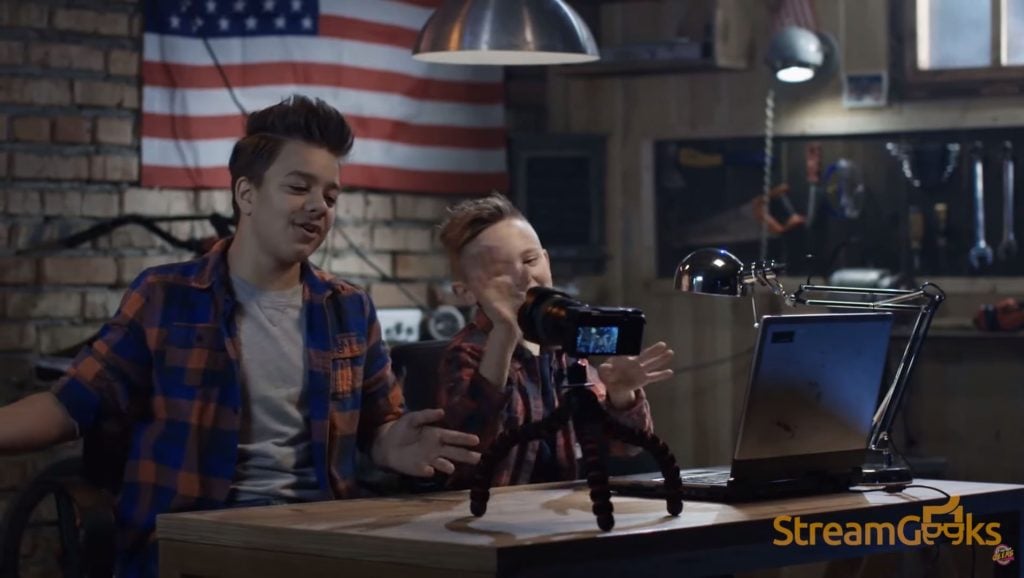Morning Announcements through Broadcast Clubs
Written by Paul Richards on April 29, 2019
Morning Announcements
It’s no surprise that student retention rates skyrocket when it comes to hands-on learning (MicroTek, 2017). Hands-on learning increases our engagement because it provides us the opportunity to interact with subject matter in a way that feels real. When it comes to understanding broadcast television and streaming media, there is no better way to learn. Walking into a student-run production room during the morning announcements is a sight to see. It may sound cliche, but practice does make perfect and the students at Griswold High School in Griswold, Connecticut, get 180 days of practice every year. As an added bonus, the entire school gets updated on important school news, the weather and birthdays.
I first met the 2018 class of the Griswold High School’s student-run broadcast club on the 2018 Streaming Awards show. The Streaming Awards are an annual event hosted by the StreamGeeks; we started to acknowledge live streaming shows from around the world. This awards show happens every year and the voting is 100% audience driven. With hundreds of contestants from all around the world, some members of our audience were surprised that a high school news announcement team was hovering around the number one and number two ranks for the popular vote.
Teacher Timothy Moore started the Griswold School Broadcast Club in 1991 and this year the club has 16 student members from grades nine through twelve. The Griswold Broadcast Club reflects the organizational structure of a traditional television production studio which includes a producer, director, technical director, audio chief, teleprompter chiefs, character generators and on-screen talent. An organizational structure like this allows students to come into the program as a freshman and rise through the ranks each year. Moore takes on the producer role during each student announcements production. “It is a student-run organization; I am just here to sit back and watch things go smoothly… and maybe solve some problems here and there when they arise… the students get 180 days of practice each year” says Moore.
The director role is the most important role in the organization and it is generally held by a senior in the club who has excelled through the ranks of the broadcast club. This role is held in such high esteem that a wall in the production studio is dedicated to pictures of past directors. The director must arrive at 7:15, which is 15 minutes earlier than the rest of the team. This role is responsible for checking in with every department head to make sure everything is running smoothly and on-time. Here is a list of duties the director is responsible for:
- Set an example and show initiative
- Focus
- Watch the clock
- Test all systems a safe time ahead
- Be ready to give warning and cues
- Delegate
- Anticipate and solve problems
- Be able to work all the equipment
- Learn the terminology
- Trace cables
- Watch meters and levels
- Review past performance and adjust
- Rehearse and practice
- Balance praise and discipline
- Emulate the experts
- Develop talent
- Take inventory
As you can imagine, this is quite a lot of responsibility for a junior or senior in high school. But Moore explained to me, “for the right student, this type of responsibility builds character and prepares students for the real world.” Here is a look at a normal day in the Broadcast Club.
- 7:15 – Students begin arriving
- 7:25 – 10 Minute Warning
- Latest director can arrive
- Plug in camera
- Set trims on microphones
- Adjust credits
- Latest director can arrive
- 7:30 – 5 Minute Warning
- Cameras must be on tripods and visible in the switcher
- Mic trim is set
- AV Test; Check cameras, set chroma key, bring up the banner, check ch19, and troubleshoot
- Turn off mics on set
- 7:34 – 1 Minute Warning
- Switch Leightronix to ch6
- Turn off PA speaker
- 7:34:35 – Quiet on set
- 30-second warning
- Turn mics back on
- 7:34:55 – Countdown from 10
- 7:35:05 – Go Live
Directors in the broadcast club are held to a higher standard than entry level positions because they have accepted the responsibility of managing others in the club. They oversee the broadcast workflow in the same way a director works at the orchestra. The technical director works directly under the main director managing the switching software. The switching software being used at Griswold High School is called vMix. The next chapter in this book will be dedicated to the technical implementation vMix inside the club’s video workflow. With the oversight of the club’s producer and director, the technical director manages the video and audio sources available inside vMix. On a normal day, this would include three camera sources and an audio source coming from the audio mixer.
The technical director and audio chief work in sync, to make sure that the audio sources are set to the appropriate levels. The audio chief sits at the audio mixing board with a pair of headphones to listen to each microphone input and set the microphone trim. The technical director will then mute all microphones on set until the notated time of 7:34:35. The audio chief also has the special responsibility of choosing the music used for the days broadcast. Teamwork is paramount here and having all club members working in sync is incredibly important. Everyone in the broadcast club needs to have a working knowledge of the entire workflow. Here is a list of items everyone in the Griswold High School Broadcast Club has a working knowledge of:
- Identify audio and video cables
- Put together a camera kit
- Bring up teleprompter file and hook it into the monitor
- Cue videotapes / digital recordings
- Set audio levels
- Operate the main switcher
- Ride audio levels
- Trace video cables
- Trave audio cables
- Set up the chroma key
- Set up lights
- Update Titles
- Update public access on both machines
- Manually focus and adjust the iris on all cameras
- Recharge batteries
- Switch Leightronix between PowerPoint, Videonics, and studio
- Program Leightronix for public access
During a live interview on the 2018 Streaming Awards show, Moore said “We started this club originally just as the morning announcements. We started on VHS over 25 years ago. Ryan is the student director (2018) is a senior about to graduate. Kristin is going to be our director next year.” Moore helps train students in the art of video production. On a recent interview, he stressed the importance of developing a “can-do” attitude with the students. Moore has developed what he calls the “3P Pledge” which is posted in the morning announcement classroom and reads “We are Professional. We set high standards and emulate the experts. We are Proficient. We are able to use all the equipment in the room and produce high-quality video. We are Proactive. We anticipate shortcomings and problems before they arise and prevent them.”
Moore explained to me that there is often a waiting list of students who want to join the club which is why the club makes on-time attendance a high priority. The club has a tardiness policy which is simply “three strikes and you are out.” If students are late more than three times, they will be banished from the club for 45 days. It’s that simple. Also posted in the “Morning Announcements Homeroom Notes” you will find this posted about the tardiness policy “Office excused tardies and late buses are all that will be accepted. You are very important for making the announcements flow smoothly. Any arrival beyond 7:30 is considered a tardy by me. See me if this presents a problem. All levels – managements and lackeys (future management) – are allowed three tardies. All offenders after that will be ostracized to the general populace for 45 days and remain tardy-free for that time period to return.”
Clearly posting rules like this will build trust and responsibility inside the broadcast club. One of the club’s members on the Streaming Awards said “I know personally that being able to be a part of this coming up from Freshman year, has really made quite a difference in my life. Everyone down here that is part of the crew has become like a family. It builds great character. It has helped make coming to school each day even better. This is the place where I found out what I want to do with the rest of my life.”
As students rotate through roles and gain positions with more responsibilities, the on-air reader, teleprompter chief, and character generator positions are generally great starting places. The on-air reader role is ideal for students who want to develop their speech and ability to articulate clearly. Students with on-camera positions learn the importance of eye contact. On-air readers learn how to talk to an audience as opposed to reading to them. For students that prefer an off-camera position, the character generator and teleprompter positions are great choices. Operating a teleprompter involves real-time teamwork with the on-air reader. This entry level position is a crucial part of the entire workflow and “Broadcast Club Family.” Since every Director was once a teleprompter operator or on-air reader, the student-run organization can support itself with the experience required for delegation and troubleshooting. Another student in the 2018 broadcast club class said “This group helps you build a lot of responsibilities and character because each one of us has our own individual jobs. We are teleprompter chiefs, we have people who are audio chiefs and character generators and I know ever since I became a co-chief that I come in every day and I can do my work a lot faster than I used to be able to do before.”
Giving students the opportunity to perform inside a live video production environment is an empowering experience. Another student said during the 2018 Streaming Awards Show “My favorite part is the learning and growing. I remember coming in the first day of freshmen year and being told that I was going to be the on-air reader for the day and I would stutter and it was a terrifying thing. And then I came in halfway through my sophomore year as the chief teleprompter which made it so that if no one else wanted to read, I would have to pick up most of the slack. So that by that time I learned how to keep learning and growing and making sure that I was literate and able to perform just like everyone else. The experience is important, even if you aren’t going directly into the field after you graduate… we can still say that we had this program in high school… so we know how some of this technology works already.”
Now, let’s dig into the nitty-gritty technology that the Griswold High School is using to provide technical jobs for each member of the broadcast club. Many upgrades have been made since the club’s first year in 1991, over 25 years ago. Moore still keeps a closet full of analog gear around for the sake of historical perspective. The way the clubs has grown over the past few years is quite incredible. This student-run broadcast club now uses some of the most advanced video production software available in a way that I find ingenious. In the next chapter, we will lay out the club’s technology setup and explain how they deliver morning announcements to the entire school and local public access television channel with a production crew of 10+ students.









